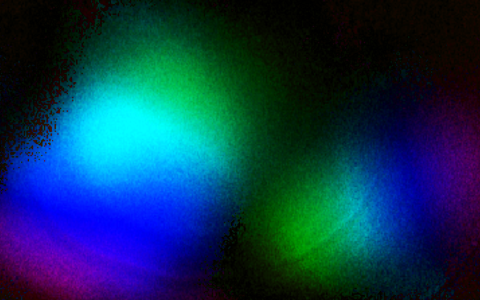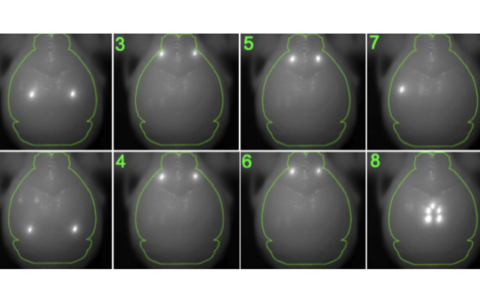
Off-target effects of optogenetics
By April Cashin-Garbutt
Optogenetics has transformed neuroscience. Through the ability to turn neurons on/off very quickly in a spatially precise manner, the technique has enabled researchers to dissect neural circuits and understand their causal relationships in a way that was previously impossible through irreversible lesion studies.
However, as with any groundbreaking technique, optogenetics comes with its own set of challenges. Here’s the story of how one such challenge led to the discovery of off-target effects of light stimulation used to activate genetically encoded light channels and how these might be overcome.
Unintended activation of neurons
When carrying out an experiment to understand the spontaneous activity of neurons in darkness, SWC Research Fellow Simon Weiler used the expression of an exogenous opsin paired with red stimulation light through an optical fiber to activate a specific cell-type within the brain.
To his surprise, he observed a huge effect on neurons across all layers within the cortex. This is not what he expected as he believed he had only activated a small subset of cells and had anticipated the effect to be much more subtle.
To figure out what was happening, Simon followed up with a control experiment where he did not express the light-sensitive ion channel, but instead just a fluorophore. When he turned on the red light during the control, he saw the same result – activity everywhere!
Going one step further, Simon light-stimulated in a wildtype animal with no expression of opsins and fluorophores whatsoever and still he found evoked responses in many cells when the red light was turned on. Simon wondered whether this off-target activation of cortical neurons was due to laser light striking the back of the retina which could then trigger neuronal responses in downstream circuits.
“Irrespective of the mouse expressing exogenous opsins or not, the results always looked very similar. I observed huge activity with a specific time delay always across all cortical layers. We realised that this must be caused by the light we shine within the brain,” explained Simon.
Light-induced neuronal activity from within the brain
Today light sensitive channels can be designed to be responsive to different wavelengths such as red, orange and blue. The researchers observed similar results for all three wavelengths over a range of stimulation intensities (1-15mW) usually used for in vivo optogenetic experiments.
“Even at 1mW when we have complete darkness, we see off-target effects for all wavelengths. And so that means that you should be extremely cautious performing an optogenetic experiment in darkness with any wavelength at 1mW,” advised Simon.
The problem researchers face is that laser power intensities below 1mW may not be sufficient to activate the required neurons, but at 1mW the researchers observed off-target evoked activity.
Exploring the effects of red, orange and blue light
Simon had planned to use a red laser in his original experiment, as red light is commonly thought to be invisible to rodents and so they would not be able to detect the laser light. Recent research from Roche Innovation Center Basel has brought this common assumption into question, as a team of researchers there demonstrated that rodents are not red-light blind.
In addition, Simon’s work showed that red light has the strongest off-target effects. This is likely due to the fact that red light does not scatter to the extent of blue and orange light, which means it can penetrate through brain tissue more easily.
“The photons from red light accumulate more efficiently at the retina because less photons are scattered in the brain. This could explain why we saw the strongest effect when stimulating with red light,” explained Simon.
Crafting a solution
Addressing this issue required an understanding of the biology of the retina. Simon and the team devised a solution centred on light adaptation. By exposing the retina to ambient light, they could mitigate the exaggerated neuronal responses caused by laser stimulation.
“When the retina is dark adapted, fewer photons are sufficient to evoke neuronal activity in the brain. By desensitising the retina with ambient light, we were able to reduce the activation efficiency of the laser light and thereby solve the problem of off-target optical-stimulation evoked cortical activity,” explained Simon.
This approach involved carefully balancing the intensity of ambient light and the power of the optogenetic stimulation laser within the brain. Simon emphasised the importance of this balance, noting that excessive laser power could still induce unwanted neuronal activity:
“You must titrate the ambient light presented to your animal on the monitor with the light from the laser. Then you need to do the control experiment to check that there is no neuronal activation when there are no exogenous opsins in the brain."
Practical implications and future directions
The discovery of these off-target effects of light stimulation used for optogenetic experiments serve as a crucial reminder to conduct thorough control experiments and consider the potential for unintended light-induced activity.
“In addition to doing these control experiments, it is important to be extremely careful when conducting in vivo optogenetic experiments as the light we use to activate neurons within the brain can have pronounced off-target effects. When choosing your wavelength, probably avoid using red where possible and opt for blue or orange light,” advised Simon.
Looking ahead, Simon hopes that colleagues will be cautious regarding the behavioural impact of these off-target effects. These electrophysiological data are consistent with an under cited 2015 study from Allen Institute for Brain Science, which showed that illumination can evoke a behavioural artefact in mice that compromises their performance in a visually guided discrimination task.
The team are also exploring other potential solutions to tackling the off-target effects. One promising idea involves integrating a constant white LED within the optical fibre to maintain light adaptation even in complete darkness. This innovative approach could offer a solution that is independent of environmental luminance levels and permit freely moving behaviour.
Find out more
- Read the preprint in bioRxiv, ‘Overcoming off-target optical stimulation-evoked cortical activity in the mouse brain in vivo’
- Read the peer-reviewed paper in iScience
- Learn more about research in the Margrie Lab


